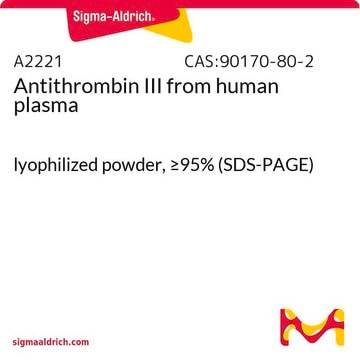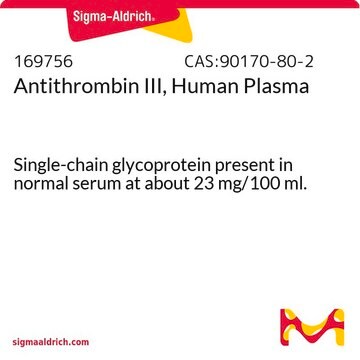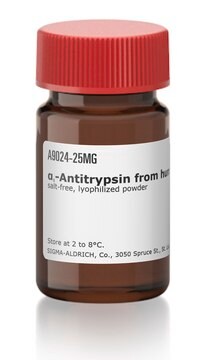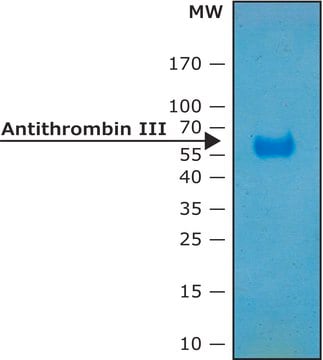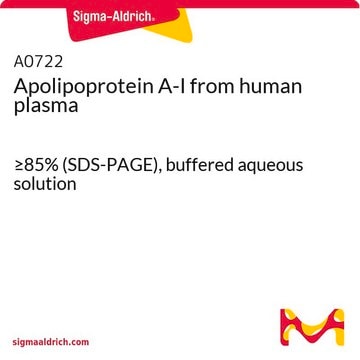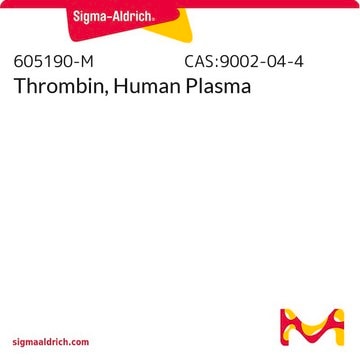SRP6316
Antithrombin III from human plasma
≥95% (SDS-PAGE)
Synonyme(s) :
SERPINC1
Se connecterpour consulter vos tarifs contractuels et ceux de votre entreprise/organisme
About This Item
Code UNSPSC :
12352202
Nomenclature NACRES :
NA.32
Produits recommandés
Source biologique
human
Pureté
≥95% (SDS-PAGE)
Forme
lyophilized
Poids mol.
58 kDa
Conditionnement
pkg of 100 μg
pkg of 500 μg
Numéro d'accès UniProt
Conditions d'expédition
wet ice
Température de stockage
−20°C
Informations sur le gène
human ... SERPINC1(462)
Description générale
SerpinC1, also known as antithrombin III (AT III), is a member of the serpin superfamily of serine protease inhibitors. The gene is mapped to human chromosome 1. SerpinC1 is a glycoprotein with three β-sheets and nine α-helices. The protein has an active site region and a heparin binding site.
Actions biochimiques/physiologiques
SerpinC1, also known as antithrombin III (AT III), has been found to be a marker for disseminated intravascular coagulation (DIC) and to be of prognostic significance in septic patients. Antithrombin III synthesized in the liver is the principal plasma serpin of blood coagulation proteases and inhibits thrombin and other factors such as Xa by the formation of covalently linked complexes. Thus, it is one of the most important coagulation inhibitors and the fundamental enzyme for the therapeutical action of heparin. The inhibitory activity of AT III undergoes a dramatic increase in the presence of heparin and other glycosaminoglycans. Antithrombin III mediates the promotion of prostaglandin release, an inhibitor of leucocyte activation and downregulation of many proinflammatory cytokines. It exerts anti-inflammatory properties in addition to its anti-coagulative mechanisms. The deficiency or functional abnormality of AT III may result in an increased risk of thromboembolic disease, such as deep vein thrombosis and pulmonary embolism. In addition, it has been reported that AT III can alter or influence inflammatory processes via inhibition of NF (nuclear factor)-κB activation or actin polymerization. It is found in normal serum at 15mg/100mL. Found at higher levels in plasma than in serum because of complexing with thrombin during coagulation. Clinically, reduced levels are indicative of hypercoagulability. Reduction in the levels of antithrombin III enhances the severity of renal ischemia/reperfusion injury.
Forme physique
Lyophilized from 50 mM Tris-HCl, pH 8.0, with 150 mM NaCl.
Reconstitution
In water or aqueous buffer
Code de la classe de stockage
13 - Non Combustible Solids
Classe de danger pour l'eau (WGK)
nwg
Certificats d'analyse (COA)
Recherchez un Certificats d'analyse (COA) en saisissant le numéro de lot du produit. Les numéros de lot figurent sur l'étiquette du produit après les mots "Lot" ou "Batch".
Déjà en possession de ce produit ?
Retrouvez la documentation relative aux produits que vous avez récemment achetés dans la Bibliothèque de documents.
Les clients ont également consulté
Antithrombin III inhibits nuclear factor kappaB activation in human monocytes and vascular endothelial cells.
Oelschlager C, et al.
Blood, 99, 4015-4020 (2002)
Feng Wang et al.
Kidney international, 88(4), 796-803 (2015-06-25)
Antithrombin III, encoded by SerpinC1, is a major anti-coagulation molecule in vivo and has anti-inflammatory effects. We found that patients with low antithrombin III activities presented a higher risk of developing acute kidney injury after cardiac surgery. To study this
Laboratory tests for antithrombin deficiency.
Khor B and Van Cott EM
American Journal of Hematology, 85, 947-950 (2010)
Antithrombin III supplementation in severe sepsis: beneficial effects on organ dysfunction.
Inthorn D, et al.
Shock, 8, 328-334 (1997)
The anti-inflammatory properties of antithrombin III: new therapeutic implications.
Okajima K and Uchiba M
Seminars in Thrombosis and Hemostasis, 24, 27-32 (1998)
Notre équipe de scientifiques dispose d'une expérience dans tous les secteurs de la recherche, notamment en sciences de la vie, science des matériaux, synthèse chimique, chromatographie, analyse et dans de nombreux autres domaines..
Contacter notre Service technique